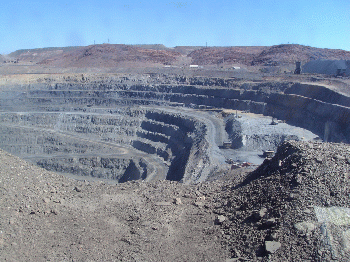
Mt Isa mines. One of the big holes adjacent to the city.
(Image by denisbin from flickr) Details DMCA
Does creating a sustainable Internet start with every Internet user learning the supply chain of one substance in their computer... and about the mineral deposits in their region?
A few years ago, a telecom engineer-friend's wife asked him about public and wildlife health impacts from exposure to telecommunications' radio-frequencies. "I have advanced degrees in engineering," he told her. "I know this stuff is harmless." Anyway, he researched her questions and the ecological impacts of manufacturing, operating and discarding telecom devices and infrastructure. He realized that during engineering school, he never considered such questions. His research changed his thinking and he began exploring ways to reduce radiofrequency exposure and the Internet's energy consumption.
Meanwhile, another friend introduced me to bioregionalism, an orientation defined by your own watershed, landforms, animal, bird and plant communities and mineral deposits. A bioregion is defined by geography not political boundaries.
Of course, we rarely define human communities now by place, since Internet access and airplanes provide international connections 24/7. Infrastructure and tools are no longer limited by the energy and ores available in any one bioregion. For more than a century, we've made infrastructure and tools from ores, chemicals and water sourced and processed from multiple continents. Living beyond our ecological means is all most of us have ever known.
This is not sustainable.
To create a sustainable Internet, would users research their own computer's supply chains and the mineral deposits in their bioregion?
In my (March 2023) Substack, Digital Enlightenment, I list about 125 substances in a smartphone. Consider it an invitation to trace one substance in your computer's supply chain and share your research.
Last week, I offered questions for getting to know your watershed.
Today, I've got questions about your region's geophysics and mining operations.
The geology in your backyard
1. What kind of soil is prevalent in your neighborhood? (Topsoil? Clay? Sandy?)
2. What grows best in your soil? How many feet would you have to dig through to reach bedrock?
3. Defining your bioregion by your watershed's boundaries, what are the primary geologic events that shaped your bioregion?
4. From what direction do storms usually come to your region? The door or windows that get wettest in a storm may give you clues and the answers may change seasonally. Or, storms may come from several directions.
(Note: You can view every article as one long page if you sign up as an Advocate Member, or higher).





